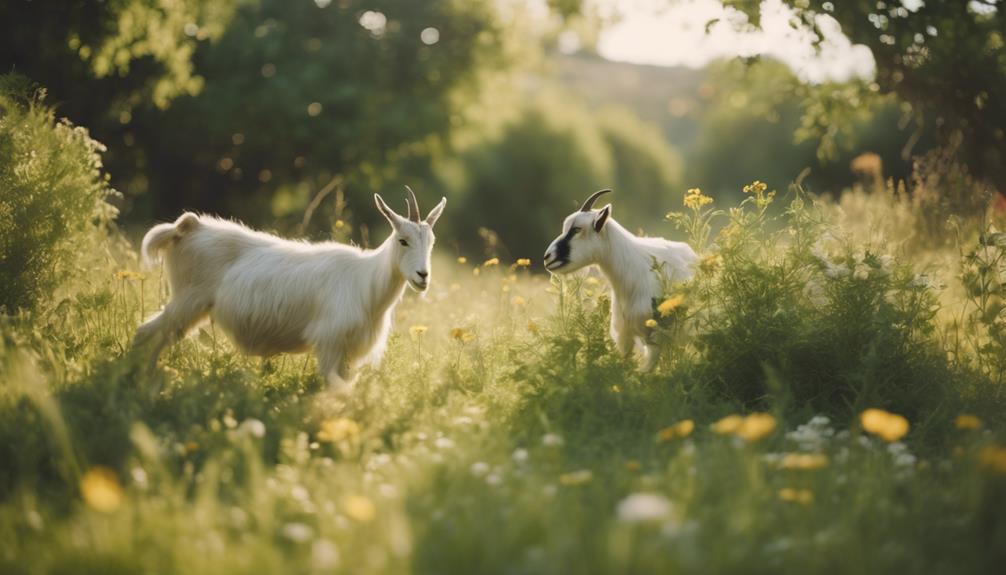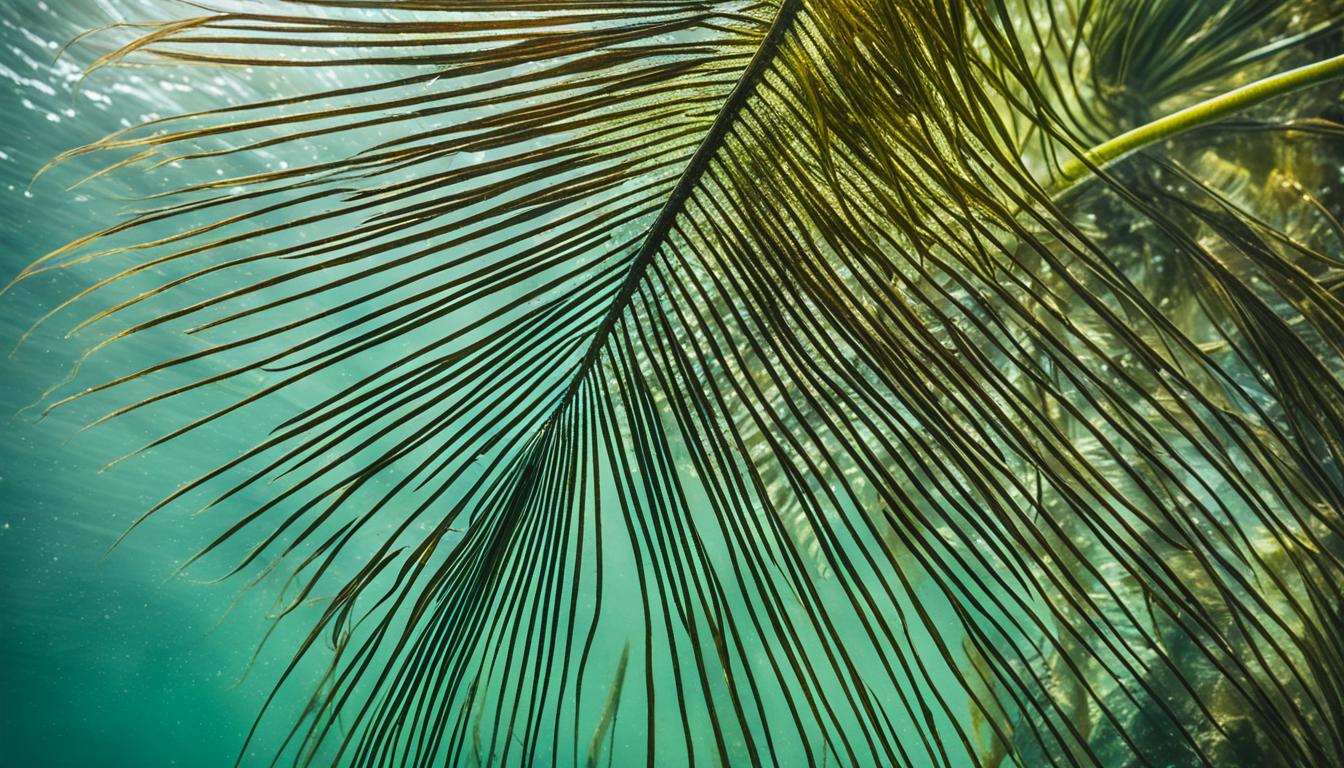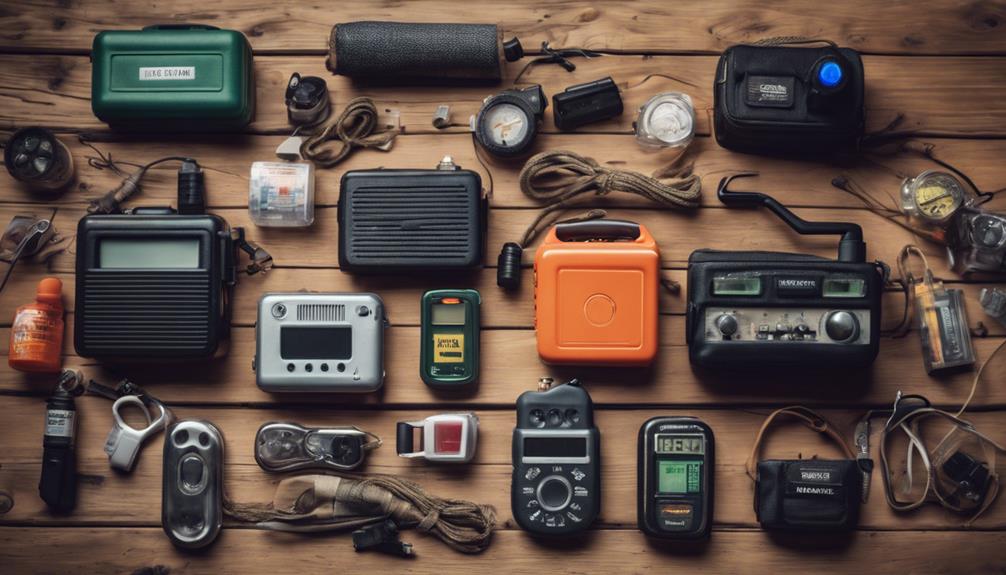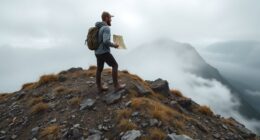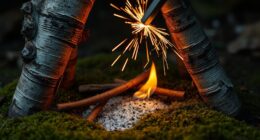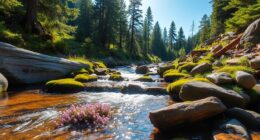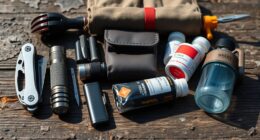Imagine strolling along the picturesque coastline of the San Francisco Bay area, surrounded by breathtaking views and the soothing sounds of crashing waves. As you explore the shore, you realize that this beautiful landscape holds a secret treasure trove: an abundance of wild edibles just waiting to be discovered and enjoyed.
Coastal foraging is a growing trend, with adventurous restaurants along the Pacific Coast incorporating wild plants into their menus. The popularity of cooking with these unique ingredients is on the rise, as people are realizing the incredible flavors and nutritional benefits they offer.
Experienced foragers will tell you that safety should always be your top priority. When venturing out to collect wild edibles, it’s essential to follow a set of common-sense rules. Pay attention to your surroundings and be cautious about foraging in prohibited areas, such as government property, private land, or hazardous locations. Stay away from roads and unstable terrains, ensuring your foraging expedition is both safe and enjoyable.
The Bay Area is a forager’s paradise, offering a diverse array of wild edibles. From the vibrant yellow dandelion blossoms to the peppery wild radish and the aromatic wild fennel, there is a myriad of flavors to explore. Don’t forget to keep an eye out for sea beans, Douglas fir, asparagus, wood sorrel, miner’s lettuce, purslane, and lamb’s quarters during your foraging adventure.
Foraging is not only about indulging in culinary delights but also about sustainability and environmental responsibility. Seasonal variations and species knowledge are crucial for successful foraging, as they ensure the proper growth and preservation of edible plants. Familiarize yourself with reputable field guides, books, websites, and guided tours to enhance your foraging skills and expand your knowledge.
It’s worth mentioning that local foragers often keep their favorite spots secret. This practice aims to sustain the abundance of certain plants, allowing for future generations to enjoy the wonders of coastal foraging. By understanding which plants are in season and their growth habits, you can embark on a successful foraging expedition in the Bay Area.
Key Takeaways:
- Coastal foraging in the San Francisco Bay area is a prime opportunity to discover wild edibles.
- Restaurants along the Pacific Coast are embracing the use of wild plants in their menus.
- Following common-sense rules and prioritizing safety is crucial when foraging.
- The Bay Area is home to a variety of wild edibles, including dandelion blossoms, wild radish, wild mustard, wild fennel, and more.
- Sustainability and environmental responsibility are key principles of foraging practices.
The Art of Foraging: Know Before You Go
Before venturing out to forage along the coast, it’s important to have a basic understanding of foraging techniques and coastal plant identification. By familiarizing yourself with these essential skills, you can make your foraging experience both safe and fruitful.
One of the best ways to prepare for coastal foraging is to do some research and reading. Field guides, such as Euell Gibbons’ classic book, Stalking the Wild Asparagus, provide valuable information about wild edibles. These resources can help you identify different plants and learn how to harvest them responsibly.
If you’re new to foraging, it’s highly recommended to learn from knowledgeable mentors or join guided tours and tutorials. In the Bay Area, there are experienced foragers and organizations like ForageSF that offer classes and workshops to help beginners get started. These educational experiences provide hands-on learning opportunities and guidance on foraging techniques specific to the coastal environment.
When you go foraging, always remember to bring a local field guide with pictures and descriptions of the plants in your region. This guide will be an invaluable resource in identifying the wild edibles you encounter along the coast.
Remember, foraging is an art that requires knowledge, patience, and respect for the environment. By equipping yourself with foraging techniques and coastal plant identification, you’ll be ready to embark on your coastal foraging adventures in the Bay Area.
| Foraging Techniques | Coastal Plant Identification | Sustainable Foraging Bay Area |
|---|---|---|
| Research and reading | Use field guides | Practice ethical harvesting |
| Learn from knowledgeable mentors | Join guided tours and tutorials | Respect foraging regulations |
| Attend foraging classes and workshops | Bring a local field guide | Harvest responsibly |
Foraging Ethically and Responsibly
When it comes to coastal foraging in the Bay Area, it’s essential to prioritize sustainability and responsible harvesting. By following ethical practices, you can ensure the preservation of local ecosystems and the long-term availability of wild edibles. Here are some guidelines to keep in mind:
- Obtain permission: Never forage on government property or private land without proper authorization. Respect the boundaries and regulations set by landowners and authorities to protect both the environment and yourself.
- Avoid hazardous areas: Be aware of potential risks associated with certain locations, such as landfills or unstable terrains. Plants have the capacity to absorb toxins from the ground, so it’s crucial to avoid foraging in contaminated areas.
- Stay away from roads: Foraging near busy roads can expose plants to harmful pollutants from passing vehicles. Steer clear of roadside areas to ensure the edibles you collect are safe for consumption.
- Protect secret spots: If you discover a prime foraging location, keep it to yourself. Sharing secret spots can lead to over-harvesting and potentially harm the sustainability of the plants. Respect the trust of others who share their favorite spots with you.
Remember, sustainable foraging in the Bay Area is not just about enjoying the treasures of nature; it’s also about contributing to the preservation of local ecosystems for future generations. By foraging ethically and responsibly, you can make a positive impact on the environment and ensure the availability of wild edibles for years to come.

| Fact | Insight |
|---|---|
| Foraged mushrooms are available year-round at specialty shops like Far West Fungi in San Francisco’s Ferry Building. | Specialty shops offer a variety of mushrooms for foraging enthusiasts, allowing them to enjoy this delicacy throughout the year. |
| Cutting-edge chefs seek out rare foraged foods in trendy restaurants like Berkeley’s Chez Panisse. | Top chefs are incorporating foraged ingredients into their culinary creations to offer unique and sustainable dining experiences. |
| Public lands in the Bay Area have strict limitations on foraging; foraging for mushrooms is illegal in most state, regional, and town parks in Sonoma County, except for Salt Point State Park. | It’s crucial to be aware of legal restrictions when it comes to foraging on public lands in the Bay Area. Always research and respect the regulations of each specific area you visit. |
| Mike Twyford, a master mushroom hunter in the Bay Area, doesn’t sell the mushrooms he finds, emphasizing his passion for foraging over commercial motives. | Foraging is not always driven by commercial gain. Many enthusiasts, like Mike Twyford, prioritize their love for the practice above financial considerations. |
| ForageSF, a local organization for foragers, charges guests around $100 or more for their foraged food dinners, moving from a hobby to a business model. | ForageSF has transformed foraging into a sustainable business model, offering unique dining experiences centered around wild edibles. |
| Foragers strip seaweed from rocks, engage in unlimited poaching, and gather without restraint, risking the survival of native animals and damaging the environment according to Breck Parkman. | Reckless foraging practices such as stripping seaweed and engaging in unchecked poaching can have detrimental effects on native species and the overall ecological balance. |
| Jonah Raskin recounts his experience with Kevin Feinstein, who emphasizes the need for sustainable foraging practices to prevent environmental degradation. | Practicing sustainable foraging is crucial for preserving the natural environment and preventing damage to delicate ecosystems. |
| Iso Rabins dives off the California coast for abalone and sea urchins and educates about the abundance of life under the ocean surface. | Foragers like Iso Rabins not only harvest seafood but also raise awareness about the diverse marine life and the importance of sustainable practices. |
| Most herbalists adhere to the rule of picking only 10 percent of a patch of wild plants. | Responsible herbalists understand the significance of leaving the majority of wild plants untouched to ensure their continued growth and sustainability. |
| Some plants like chickweed in Marin have seen a decline in population due to foraging, affecting their sustainability. | Over-foraging of certain plants can lead to population decline and threaten their long-term sustainability. |
| Foraging on heavily trafficked roadsides, by polluted streams, and near conventional farms using pesticides should be avoided due to herb absorption of toxins. | Location matters when it comes to foraging. Avoid areas with high levels of pollution or chemical exposure to maintain the safety and quality of the edibles you collect. |
| Some herbalists caution against harvesting trillium roots as it can lead to the death of this delicate plant. | Understanding the impact of foraging on specific plant species is crucial. Delicate plants like trillium require careful consideration to ensure their survival. |
| In Marin County, incidents of poison hemlock poisoning have been on the rise, potentially due to an increasing population of foragers. | An influx of foragers has led to an increase in incidents of poison hemlock poisoning in Marin County, highlighting the importance of responsible foraging practices. |
| Foragers should be cautious with plants like Pedicularis, which can absorb toxic properties from other plants, especially if grown near poison oak. | Some plants have the ability to absorb toxins from their environment. When foraging, take precautions with plants like Pedicularis, particularly if they are found near poison oak. |
| Marin County parks have regulations prohibiting gathering of plants in most areas except open space preserves where limited berry gathering is allowed. | Being aware of local regulations is essential to ensure you are foraging within permitted areas and adhering to the guidelines set forth by the authorities. |
| California Indians have a long history of using irises for cordage, showcasing sustainable plant use. | Indigenous communities have practiced sustainable plant use for generations, demonstrating the importance of respecting and learning from their traditional knowledge. |
| Ethical foraging requires learning the story and place of the area to interact responsibly with the plants. | Developing a deep understanding of the natural environment and its history is essential for ethical foraging. Respect and responsibility go hand in hand when interacting with nature. |
Seasonal Foraging and Location
Understanding the seasons and locations for foraging is essential when it comes to wild edibles in the Bay Area. Different plants and edibles have specific seasons when they are at their peak freshness and flavor. Let’s explore some of the seasonal highlights and where to find them.
Spring Bounty
Spring is a vibrant time for foraging in the Bay Area. Wild radish is one of the notable wild edibles that come into full bloom from April to July. Their vibrant white and pink flowers are hard to miss, and the young leaves and seed pods are a delicious addition to salads and stir-fries.

Another spring treasure is asparagus, which is best harvested in spring and early summer. Keep an eye out for their tender shoots rising from the ground, especially in meadows and fields. Stalking these spears of green goodness is a delightful experience that results in culinary delights.
In addition to wild radish and asparagus, miner’s lettuce is a star of the spring season. Although it can also be harvested in summer and autumn, its fresh, tangy leaves are abundant in spring. Look for these heart-shaped leaves in shady areas, often near streams or in damp woodlands.
Year-Round Finds
While some wild edibles have specific seasons, others can be found throughout the year. Sea beans, for example, are available year-round but are most abundant in the early spring and fall. These succulent, salty plants are commonly found along sandy beaches and coastal areas.
Another year-round gem is wood sorrel, a delicate edible plant with sour, lemony leaves. Wood sorrel can be harvested from spring through autumn and can be found in wooded areas, clearings, and even your own backyard.
Exploring the Bay Area
The Bay Area offers diverse ecosystems, making it a haven for foragers. Whether you prefer the coastal regions, hillsides, or meadows, there are plenty of locations to discover wild edibles.
“Northern California is highlighted as one of the best places in the country for foraging wild foods due to its mild winters and diverse ecosystems,” according to ForageSF.
Foraging classes and workshops are also available throughout the Bay Area to enhance your foraging knowledge and skills. ForageSF offers guided foraging classes ranging from the Santa Cruz Mountains to the Sierra, providing you with insights into the local flora and sustainable foraging techniques. These classes typically last three to four hours and cost between $120 and $135.
| Foraging Opportunities | Location | Cost |
|---|---|---|
| Sonoma County Mycological Association | Salt Point State Park | $20 for adults, free for kids under 16 |
| Sea Forager | Coastal locations | $75 per person (2.5 – 3 hours) |
| HarvestWild | Shasta County | Varies |
| Mountain Sea Adventures | Santa Cruz | $75 for adults, $45 for kids (6-12) |
From mushroom forays to coastal fishing and foraging classes, there are numerous opportunities to learn from experienced foragers and connect with like-minded individuals who share a passion for the natural treasures of the Bay Area.
Whether you’re a seasoned forager or just starting your journey, seasonal foraging and understanding the diverse locations in the Bay Area will enhance your foraging adventures. Take the time to explore and savor the flavors of the region, and let the abundance of wild edibles inspire your culinary creations.
Delights of Coastal Foraging: Wild Edibles
Exploring the Bay Area’s coastline offers a delightful array of wild edibles to satisfy your culinary adventures. From vibrant dandelion blossoms to flavorful wild radish and mustard greens, the coast is a treasure trove of natural ingredients waiting to be discovered. Let’s dive into some of the wild edibles you can find along the Bay Area’s coast:
Dandelion Blossoms
Don’t let their common presence fool you – dandelions offer more than just wishes. The leaves of dandelion can be used in salads or prepared like spinach, while the bright yellow blossoms add beauty and flavor to dishes.
Wild Radish
Wild radish flowers are not only visually stunning but also bring a peppery taste to your meals. They can be used to enhance salads or add a unique twist to your favorite dishes.
Wild Mustard
Make a statement with wild mustard greens, which can be enjoyed in salads or cooked as delectable potherbs. Their bold flavor adds a delightful zing to any dish.
Wild Fennel
In the spring, wild fennel offers aromatic fronds that can be used to add a burst of freshness to your culinary creations. In the summer, the pollen of wild fennel can be harvested and incorporated into a variety of dishes.
In addition to these options, the Bay Area’s coast provides a diverse selection of wild edibles, including sea beans, Douglas fir tips, asparagus, wood sorrel, miner’s lettuce, purslane, and lamb’s quarters. These ingredients offer unique flavors, textures, and nutritional value to elevate your foraged meals.

Remember, while foraging along the coast, it’s important to accurately identify edible plants and steer clear of toxic lookalikes. Familiarize yourself with local regulations, such as the prohibition of harvesting gooseneck barnacles along the California coastline. By practicing responsible foraging techniques, you can enjoy the delights of coastal edibles while preserving the environment for future foragers.
Seaweed Harvesting: The Ocean’s Bounty
Seaweed harvesting is an exciting and delicious aspect of coastal foraging in the Bay Area. Marine algae, commonly known as seaweed, offers a wide variety of flavors and textures. With 640 different species of seaweed along the California coast, there is a vast oceanic pantry waiting to be explored.
Some well-known seaweeds that can be found in the Bay Area include bladder wrack, nori, dulse, wakame, and sea palm. Bladder wrack, for example, is known for its high iron and iodine content and can be found in health food stores.
Enjoying Nutritious and Versatile Seaweed
Seaweeds are not only delicious but also highly nutritious. They are rich in iodine, potassium, trace minerals, and dietary fiber, offering numerous health benefits. Incorporating seaweed into your diet can boost your immune system and support thyroid function.
Seaweeds can be used in a wide range of dishes, from classic sushi rolls to hearty soups and refreshing salads. Nori, for instance, is often used as a wrap for sushi rolls, while kombu is commonly used to enhance the umami flavor in stocks and broths. The world’s annual yield of nori, a popular type of seaweed, is approximately 350,000 tons, with a value of around a billion dollars in aquaculture.
Harvesting Responsibly for Sustainability
When harvesting seaweed, it is essential to practice sustainable foraging techniques. It is recommended to only harvest a small portion of each individual plant, typically no more than 25%, to allow for regeneration. This ensures the long-term health and sustainability of the seaweed population.
Harvesting seaweed responsibly also involves obtaining the necessary permits and licenses. In the state of California, where seaweed harvesting is a regulated activity, there are currently only about 20 people with permits, primarily located in Mendocino. This exclusivity reflects the importance of maintaining the delicate balance between foraging and sustainability.
Joining the Seaweed Foraging Experience
If you’re eager to learn more about seaweed harvesting, consider joining a guided tour or taking a class with experienced foragers. For example, Spencer Marley’s seaweed foraging tour offers a unique opportunity to explore the abundant seaweed along the Bay Area coast. With over 1,200 days spent at sea as a commercial fisherman, Marley brings extensive knowledge and expertise to the experience.
“Most of what I knew about seaweed was learned from taking a class with Heidi the previous year,” one of the foragers shared.
These foraging experiences usually last beyond the designated 90 minutes, as enriching content is shared during the sessions. To join Spencer Marley’s seaweed foraging tour, you can contact him at 805-441-3603.
Remember, when harvesting seaweed, always be aware of any shellfish advisories or health risks associated with consuming raw seafood. Ensuring your safety and the health of the marine environment is paramount.
So, grab your seaweed identification guide and venture into the ocean’s bounty to discover the wonders of edible seaweed in the beautiful Bay Area.

Exploring Tidepools: Unveiling the Hidden Gems
Tidepools are fascinating ecosystems that offer an abundance of treasures for foragers. When exploring tidepools, be mindful of the fragile environment and avoid stepping on or disturbing marine life. Take a moment to appreciate the breathtaking beauty and diversity of the living organisms that call the tidepools home.
Coastal plant identification plays a crucial role in tidepool foraging. Familiarize yourself with the various types of seaweed, sea grasses, and other coastal plants that can be found in tidepools. This knowledge will not only enrich your experience but also help you identify edible and medicinal plants that you may encounter.
Seashore foraging techniques are essential when exploring tidepools. Look for sea urchins, mussels, and other edible creatures hiding among the rocks. Remember to follow sustainable foraging practices and only harvest what you need, leaving enough for the ecosystem to thrive.
“In every walk with nature, one receives far more than he seeks.” – John Muir
Exploring tidepools is not just about foraging for food, it’s also an opportunity to learn about the intricacies of marine life and the delicate balance of coastal ecosystems. Consider bringing a field guide or joining guided tours to deepen your understanding of the plants and animals you encounter.

| Location | Notable Marine Life |
|---|---|
| Montaña de Oro State Park | Starfish, urchins, sea anemone, crabs, sea slugs |
| Morro Strand Beach | Starfish, urchins, sea anemone, crabs, sea slugs |
| Pismo Beach’s Dinosaur Caves Park | Starfish, urchins, sea anemone, crabs, sea slugs |
From starfish and urchins to crabs and sea anemones, tidepools are teeming with life. Take the opportunity to closely observe and appreciate these creatures in their natural habitat. Remember to tread carefully and avoid disturbing the delicate balance of the tidepool ecosystem.
Whether you’re an experienced forager or a curious novice, exploring tidepools is an adventure that offers endless discoveries. It’s a chance to connect with nature, learn about marine ecosystems, and perhaps even find a delicious treat or two along the way. So grab your sturdy shoes, a sense of wonder, and embark on a tidepool foraging journey like no other. Be mindful of the ever-changing tides, and always check local tide charts before setting out to ensure safe and successful foraging. Some essential tide pool exploration tips include treading lightly to avoid disturbing fragile marine life and being respectful by leaving no trace behind. With patience and care, you might uncover hidden treasures such as colorful seaweeds, shellfish, or even a glimpse of elusive creatures like sea anemones and starfish.
The Adventure Continues: Sea Urchin Foraging
Sea urchin foraging along the California coastline is a thrilling and rewarding experience. With the state promoting uni foraging to restore balance in the marine ecosystem affected by kelp overgrowth, it’s an opportunity to contribute to environmental preservation while enjoying a delicious delicacy. Popular foraging spots in the Bay Area include Pillar’s Point in Half Moon Bay and Fort Ross in Mendocino. The peak time for harvesting uni falls between late summer and winter, ensuring the best yield.
To increase your chances of finding uni, it’s essential to forage during negative low-tide, allowing access to more sea urchins that are further out. Before embarking on your foraging adventure, make sure you have a valid fishing license, as there is a limit of 35 uni per person per day. Additionally, it’s advisable to arrive approximately an hour before negative low-tide to maximize your chances of finding these prized treasures.
When collecting uni, it’s crucial to handle them with care. They should be stored in a cooler with ice for freshness if not consumed the same day. Consider serving uni with sushi rice and seaweed paper for a unique sushi experience, highlighting the flavors of the sea. Inside each sea urchin, you can typically find around five uni pieces, which are the edible gonads.
Shucking uni may not be a quick or easy process, but it is a fun and rewarding activity. To prepare uni for consumption, cut open the bottom section of the sea urchin and carefully spoon out the gonads. Keep the harvested uni on ice until you’re ready to savor their delicate flavor and creamy texture.

Conclusion
Coastal foraging in the Bay Area is an extraordinary journey that offers a myriad of delights for both nature enthusiasts and food lovers. From exploring picturesque tidepools and uncovering hidden gems to harvesting a bounty of wild edibles and savory seaweed, the coast holds a wealth of treasures waiting to be discovered. By embracing sustainable foraging practices and adhering to ethical guidelines, you can not only connect with nature but also contribute to the preservation of these precious ecosystems.
As you embark on your coastal foraging adventure, make sure to equip yourself with the knowledge of coastal plant identification and seashore foraging techniques. It’s important to approach foraging with respect and care for the environment, safeguarding the delicate balance of these coastal habitats. By responsibly and skillfully foraging along the bay area’s coast, you can indulge in the culinary wonders nature provides.
So grab your field guide, put on your rubber boots, and immerse yourself in the vibrant world of coastal foraging. Discover the wild edibles and abundant marine life that awaits you along the shoreline. Whether you’re gathering dandelion blossoms, harvesting nutritious seaweed, or exploring the hidden treasures of tidepools, let the beauty of the Bay Area’s coastal landscape inspire your culinary creations. Be a steward of the environment, cherish the sustainable bounties of the coast, and savor every moment of your unforgettable coastal foraging experience.
FAQ
What is coastal foraging?
Why is coastal foraging popular in the Bay Area?
How can I learn about coastal plant identification and foraging techniques?
What are some safety precautions to keep in mind while coastal foraging?
How can I find the best foraging spots in the Bay Area?
What are some popular wild edibles in the Bay Area?
Is seaweed harvesting common in the Bay Area?
What should I be mindful of when exploring tidepools?
Can I forage sea urchins in the Bay Area?
How can I contribute to the preservation of coastal ecosystems while foraging?
Source Links
- https://fromthefamilytable.com/2012/04/13/foraging-along-the-san-francisco-bay/
- https://www.kqed.org/arts/13951449/purple-sea-urchin-uni-foraging-guide-northern-california
- https://baynature.org/article/the-foragers-dilemma/
- https://www.npr.org/2022/07/24/1112898272/seaweed-foraging-class-sustainability-environment-ocean-california
- https://pacificsun.com/feature-mindful-foraging/
- https://www.7×7.com/mushroom-foraging-bay-area-2556316845.html
- https://www.floraandfungiadventures.com/
- https://msxxfast.wordpress.com/2018/01/02/foraging-in-northern-california-part-1/
- https://www.perceptivetravel.com/issues/0721/usa.html
- https://www.cntraveler.com/story/my-favorite-airbnb-experience-seaweed-foraging-california
- https://visittheoregoncoast.com/travel-guides/attractions/exploring-oregon-coast-tide-pools/
- https://baytownholidaycottages.co.uk/news/post?s=2025-03-23-fifty-shades-of-bay-part-12-unveiling-the-treasures-of-robin-hoods-bay-rock-pools
- https://highway1roadtrip.com/family-friendly-fun-along-highway-1/
- https://janiceandjoel.com/how-to-forage-for-uni-in-the-bay-area/
- https://www.catchncookcalifornia.com/
- https://www.sonomamag.com/want-to-help-restore-local-kelp-forests-try-eating-more-sea-urchins/
- https://www.sfweekly.com/archives/go-fish-s-f-s-coastal-foraging-king-shows-how-to-fish-and-eat-locally/article_8709dc60-90fb-5557-bf46-eed34519ff3c.html


